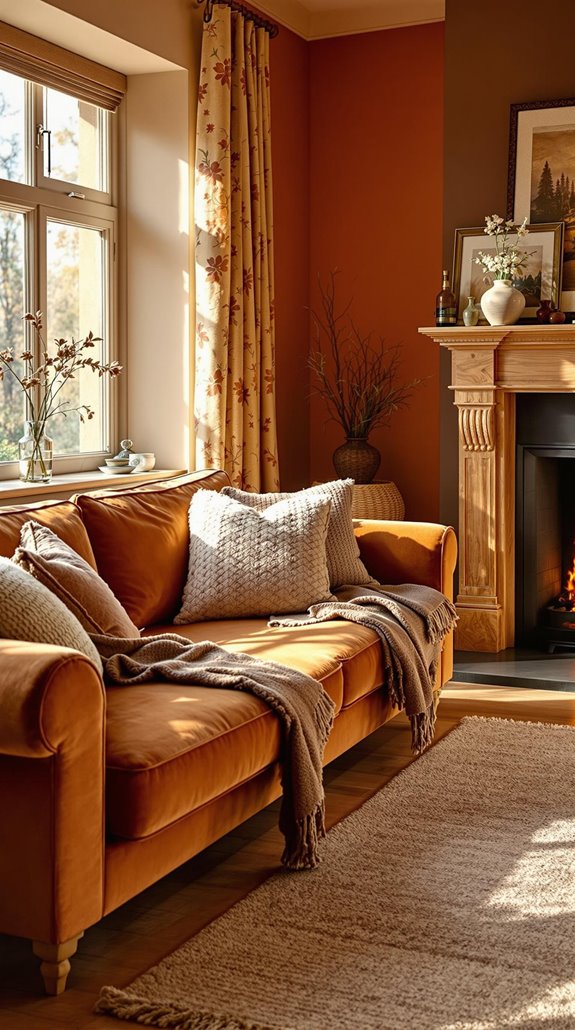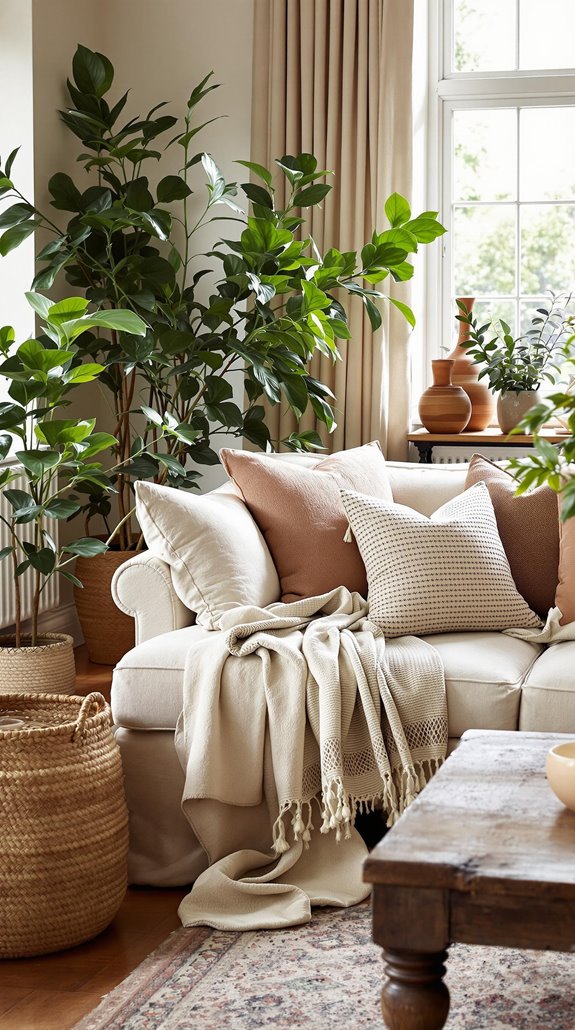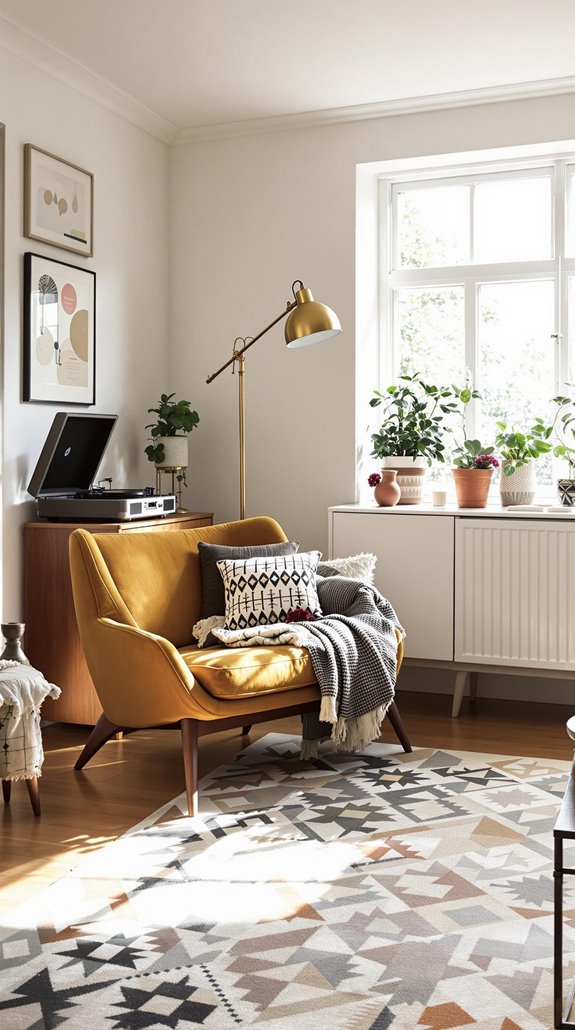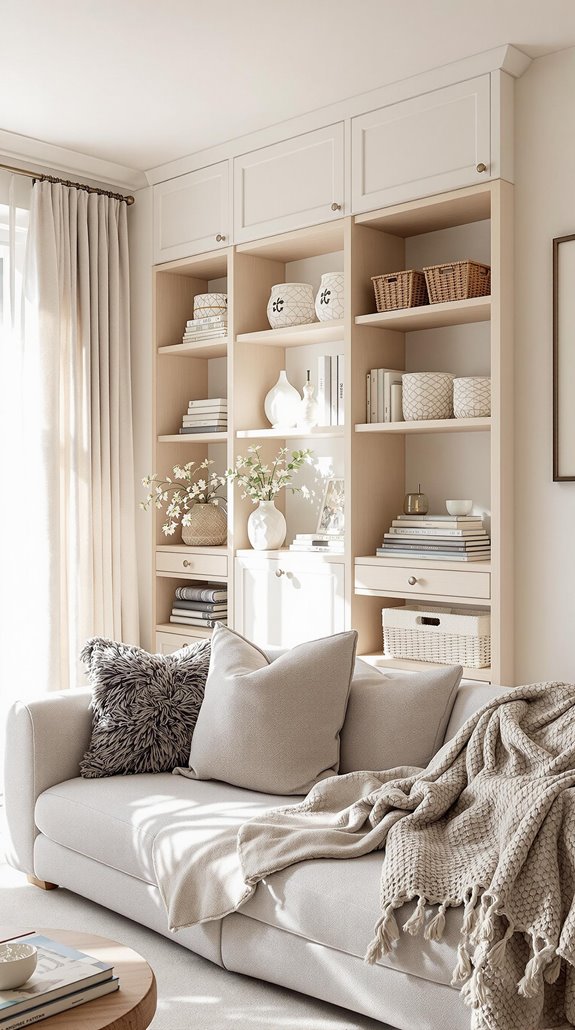I’ve helped countless homeowners transform their chilly UK living rooms into warm sanctuaries without breaking the bank. The key isn’t expensive renovations—it’s strategic choices that maximize comfort while minimizing costs. From selecting the right colour palette to arranging furniture that invites relaxation, I’ll share nine practical approaches that work specifically for British homes. These aren’t trendy fixes that’ll look dated next year; they’re timeless techniques that’ll keep your space feeling welcoming through every season.
Key Takeaways
- Use dark green, teal, and navy colour palettes with natural wood tones to create intimate, nature-inspired warmth.
- Choose curved, low-profile sofas with removable covers and kiln-dried frames for deeper lounging and easy maintenance.
- Layer ambient lighting with dimmers, warm bulbs (2700K-3000K), and strategic lamp placement for flexible cosy atmospheres.
- Incorporate organic textures like wool rugs, boucle cushions, rattan, and sheepskin to add tactile warmth and comfort.
- Maximize small spaces with multifunctional storage furniture, window seats, and wall-mounted solutions while reducing visual clutter.
Embrace Warming Colour Palettes for Ultimate Comfort

When you’re transforming your living room into a cosy haven, colour choice becomes your most powerful tool—and it won’t cost you a fortune. I’ve seen green dominate 2025’s most popular living room colours because it creates that nature-inspired calm we’re all craving. Dark green works even better, wrapping rooms in rich, enveloping warmth.
You’ll find teal and navy incredibly effective for creating cocoon-like atmospheres without overwhelming smaller spaces. While white and cream have dropped sharply in popularity (they’re simply less inviting), deep hues like navy absorb light beautifully, making rooms feel intimate and snug. Additionally, incorporating timeless colour combinations such as navy and white can elevate the overall aesthetic of your living space. Grey proves particularly ideal for low-light rooms, enhancing that moody ambiance you want for ultimate cosiness.
I recommend combining forest greens with natural wood tones or adding vibrant yellow accents through cushions—you’ll achieve that perfect balance of warmth and energy.
Layer Natural Textures and Sustainable Materials
After establishing your room’s warming colour foundation, you’ll want to build tactile richness through natural materials that won’t break your budget. I recommend starting with wool rugs – they’re incredibly durable for family homes and naturally stain-resistant. Layer in boucle cushions for that cosy loop texture we all crave.
You’ll find affordable texture through seagrass baskets and cork wall panels, both completely biodegradable. Cork also provides excellent soundproofing properties while adding natural texture to your walls. Additionally, ensure that your living space is well-ventilated to prevent early signs of damp from undermining your cosy atmosphere. I suggest hunting for second-hand wooden furniture – it adds character while keeping costs down. Mix smooth reclaimed wood pieces with nubby mohair throws for sensory contrast.
Don’t overlook jute rugs in high-traffic areas – they’re budget-friendly and withstand daily wear. These natural materials create the lived-in comfort that makes everyone feel at home.
Choose Curved and Low-Profile Furniture for Relaxation

The secret to creating a truly relaxing living room lies in choosing furniture that invites you to sink in and stay awhile. I’ve found curved sofas with low seat heights (under 18 inches) eliminate physical strain while naturally encouraging deeper lounging. You’ll discover armless designs with tight backs provide better spinal support during those Netflix marathons we all love.
Low-profile pieces create an illusion of higher ceilings, making your space feel more expansive without spending a penny on renovations. Curved sectionals naturally define conversation zones in open-plan homes, replacing expensive room dividers. I recommend kiln-dried frames with removable covers for longevity and easy maintenance. The rounded edges improve traffic flow while eliminating sharp corners that catch your legs. These organic shapes counter rigid architecture, creating that welcoming sanctuary you’ve been craving. Additionally, investing in budget-friendly strategies for your living space can help maximize its value. Consider pieces with eight-way hand-tied spring construction for superior comfort that maintains its shape over years of daily use.
Create Ambient Lighting With Layered Sources
Mastering ambient lighting transforms any living room from stark to sanctuary through strategic layering of multiple light sources. I’ll show you how to create that warm, inviting glow without breaking the bank.
Start with three lighting layers: overhead fixtures for general illumination, table lamps for mid-level warmth, and floor lamps to fill dark corners. I always recommend installing dimmer switches—they’re your secret weapon for shifting from bright daytime functionality to cosy evening relaxation. Incorporating smart technology options can further enhance your lighting experience.
Position pendant lights as focal points that add visual interest without harsh glare. Choose warm bulbs (2700K-3000K) across all fixtures to maintain consistent coziness. Don’t forget strategic placement—every corner needs gentle light to feel truly welcoming. Consider your room’s orientation when planning these layers, as north-facing spaces need extra warmth while west-facing rooms can capitalize on natural evening brightness. This layered approach creates the depth and warmth that makes everyone feel right at home.
Add Personality With Plants and Handcrafted Accessories

Plants breathe life into any living room while handcrafted accessories tell your unique story—and you don’t need a massive budget to make it happen. I recommend starting with easy-care plants like snake plants or aloe vera if you’re worried about keeping them alive. Choose decorative pots that match your style—rustic containers work beautifully with nature-inspired themes and cost less than constantly replacing plants.
To enhance your living space further, consider using cost-effective materials in your decor, which can also tie in beautifully with plant selections. Group your plants by similar care needs to streamline maintenance, and don’t overlook cascading varieties like devil’s ivy for shelves. Remember that plant containers are nearly as important as the plants themselves, with many homeowners considering them equally essential to achieving their desired aesthetic. Pair them with handcrafted accessories like woven baskets or ceramic pieces from local artisans. These personal touches create the warm, lived-in feeling that makes guests feel instantly welcome in your space.
Design Functional Zones for Better Living
Creating purposeful zones transforms your living room from a single-function space into a multi-tasking powerhouse that works harder for your daily life. I’ll show you how to achieve this without breaking the bank.
Position your largest sofa opposite the TV to anchor your entertainment zone, then use what you’ve got—bookcases, storage units, or even tall plants—as natural dividers. Break up long, narrow rooms by creating distinct areas for reading or work. Choose furniture that pulls double duty: storage ottomans, open shelving units that separate spaces while holding your belongings. Consider incorporating permitted development rights to expand your living space if needed.
Match colours across zones for cohesion, but vary your lighting. Bright task lighting for work areas, soft lamps for relaxation. Strategic rug placement helps define each zone by creating visual boundaries that signal different functions within your space. You’re creating a home that truly works for you.
Incorporate Mid-Century Modern Elements With Vintage Charm

While modern furniture can feel cold and impersonal, mid-century modern pieces strike the perfect balance between sleek sophistication and lived-in comfort. I recommend starting with one iconic piece—like an Eames chair or teak sideboard—then building around it with contemporary textiles. You’ll save money shopping secondhand markets or choosing licensed reproductions over originals. Adding stunning doorsteps to your entryway can also enhance the overall aesthetic of your home.
Layer chunky knit throws over clean-lined sofas and add jute rugs beneath angular coffee tables. I suggest pairing geometric furniture with organic textures like rattan or sheepskin to create that coveted cosy factor. Bronze bar carts and brass table lamps inject retro charm without breaking your budget.
Keep walls neutral so vintage pieces can shine, and remember—repairing original veneers beats replacing them every time. Consider mixing vintage dining chairs with a new table to create an eclectic and personalised dining area that perfectly complements your cosy living space.
Maximise Small Spaces With Multifunctional Solutions
Small living rooms demand smart furniture choices that work double duty. I’ve found that window seats with hidden storage compartments create cozy reading nooks while housing blankets and books. Storage ottomans serve as both seating and concealed storage for clutter. Incorporating multifunctional furniture can enhance both comfort and utility in these spaces.
Wall-mounted solutions free up precious floor space. I recommend floating media centers with mounted TVs and built-in shelving. Wall sconces replace bulky table lamps, giving you more surface area. Hanging baskets mounted on walls store small items without taking floor space. Visualization apps can help you plan these wall arrangements before installation to ensure optimal placement.
Corner sofas maximize seating while creating space for additional storage pieces like drum stools. Choose furniture with curved edges to improve flow and reduce sharp corners. Sleek glass-top coffee tables maintain an open feel. These multipurpose pieces help us create functional, welcoming spaces that don’t feel cramped or cluttered.
Build Storage Solutions That Reduce Visual Clutter

Since 77% of UK residents struggle with inadequate storage space, I’ll show you how to build clever storage solutions that hide clutter while maintaining your living room’s cozy appeal.
I recommend investing in multifunctional furniture that works double duty. Choose ottomans with hidden compartments that provide seating while storing throws, magazines, or games. Look for media units with concealed storage to house DVDs, cables, and remotes behind closed doors. Incorporating multi-functional furniture can significantly enhance your living room’s efficiency and aesthetic.
Maximize your vertical space with floor-to-ceiling shelving units that utilize every inch. Wall-mounted storage transforms unused corners into functional areas without eating floor space. With home renovation being one of the top reasons people seek additional storage solutions, these built-in options can serve your needs without requiring external storage facilities.
Focus on closed-door storage rather than open shelving – it maintains that tranquil, organized environment we’re all after. These solutions reduce visual chaos while keeping essentials within reach, making your space feel more open and inviting.
Conclusion
I’ve shown you practical ways to transform your living room without breaking the bank. Start with one or two changes—swap your bulbs for warm LEDs, add a wool throw, or rearrange furniture into curves. You don’t need expensive renovations; focus on budget-friendly swaps like second-hand rattan pieces and low-maintenance plants. Use what you’ve got, shop smart, and layer these elements gradually. Your cosy retreat is totally achievable on any budget.
References
- https://www.idealhome.co.uk/living-room/living-room-trends-241173
- https://styleanddecor.co.uk/16-living-room-cosy-ideas/
- https://www.decorilla.com/online-decorating/living-room-trends-2025/
- https://www.ucg.ac.me/skladiste/blog_609332/objava_105202/fajlovi/Creswell.pdf
- https://www.housebeautiful.com/uk/decorate/living-room/g63577006/living-room-trends-2025/
- https://www.countryliving.com/uk/homes-interiors/interiors/g39890151/most-popular-living-room-colours/
- https://www.thepaintshed.com/uks-perfect-home
- https://thebritishblanketcompany.com/blogs/news/cosy-living-room-colours-to-make-a-room-look-warmer
- https://www.housebeautiful.com/uk/lifestyle/property/a61947036/colours-impact-property-value/
- https://theinterioreditor.com/sustainable-living/the-eco-friendly-living-room-guide/

